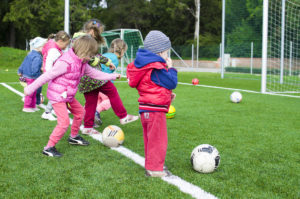Which sports are best for your child’s development?

Getting involved in sports from an early age has a myriad of benefits. It gets kids active, builds on their teamwork skills, forms new
friendships and is great for their strength building and coordination – among the various other mental, physical, social and emotional
benefits. We think that the Novak Djokovic Foundation words the benefits very well:
- Kids’ character and moral principles are formed through fair play
- Sports experiences help to build positive self- esteem in children
- Sports bring people together from all over the world, regardless of their nationality, religion, culture, or skin colour
- Teamwork and benefits of social interaction among children are best seen in sports
- Playing sports enables them to create friendships they otherwise might not have formed
- They view competitions on and off the field as opportunities to learn from their success and failure
- They learn to respect authority, rules, team colleagues and opponents
- Sport is an important learning environment for children
- Participating in sports can be a helpful way of reducing stress and increasing feelings of physical and mental well-being
While any and all sports will help to harness these important skills and experiences, we at Perform Podiatry thought we’d shed some light on
a question we occasionally get asked by parents around which sports are best for certain areas and stages of development. We thought we’d
break it down by age category and the activities and functions that are typically learnt and built on within the age range.
Preschool Age
At this age, kids are still getting their feet planted firmly on the ground and are developing a good grasp on their coordination, balance
and general motor function. At this age, it’s important to focus more on mastering the basics and less on ‘joining a team’ or looking at
competing, if it’s just for the sake of it anyway. Swimming, dancing, running, side to side movements, catching, throwing and activities
that look at improving balance and coordination, both at the feet/legs and the hands/arms, are encouraged. We remember playing bullrush and
other games at preschool that while were played with others, thinking back on them now, really focused on developing each person
individually as opposed to focusing on the team dynamics that become more important in the next age range. Spending time throwing and
catching with your kids at this age can provide just as much (if not more) value, growth and development, so make the most of this time
together.
Primary School Age
This is the time that kids can really enjoy and benefit from team sports and organised activities. They’re at school and building important
social skills and a good understanding of how a team operates together. Mentally, they’re getting stronger and have a greater focus and
drive. Physically, they’re also getting stronger and can run further for longer, throw better, and the like. They will have developed good
coordination and at this age will pick up almost any sport with great ease, working on the skills particular to that sport, if they enjoy it
that is. You can’t go too far wrong with the sports offered at primary school, some of our favourites include netball, tennis, cricket (and
generally all bat/ball sports), soccer, handball, basketball, touch rugby, running and the like. It’s also a great time to start getting
involved in activities like gymnastics, swimming and martial arts where you have a greater focus on yourself as part of the team and start
honing new skills.
Intermediate School Age
There is a lot that happens during this time and age that has an effect on kids in sport. Kids start to get quite good, confident and
skilled in the sports they’ve been playing or participating in for the years leading up to this. Part of this is their improved memory and
understanding of techniques and strategies involved in sport, as well as their improved physical strength, speed, size and general ability.
With this age comes growth spurts and unfortunately, for some kids, that also means growing pains. This means more time and care needs to be
taken on warming up, cooling down and general conditioning of muscles. This is the age that kids also start getting involved in contact
sports such as tackle rugby, that may have previously not been suitable due to inadequate strength in bones and muscles and hence a higher
risk of injury. This does need to be considered on a case-by-case basis, as every child grows and matures at varying times. Alongside all
of the previously mentioned sports, kids can start more technical sports like hockey and volleyball, if they haven’t already tried it
sooner.
High School Age
At this age, the world is their oyster! They have good, refined motor skills that have built up over the last eight years. Kids (though
they’re not so much ‘kids’ anymore) can pick up sports relatively quickly, especially if they’ve had experience playing similar sports. We
remember starting sports like fencing and underwater hockey at high-school, both of which utilised the technical skills from various other
sports and activities. Growing pains and growth-related injuries can still occur so be mindful and make sure your kids get the right
treatment and adequate rest/recovery if they develop pain or injury.
If you have any questions about this, are worried
about your child’s development, or they’re experiencing pain or injury, give our team a call on
09 523 2333
or book online! We’re the kid’s foot experts in Auckland, located at the One Health Building on Remuera Road, close to
Newmarket.

.png)
.png)